New Reports
Policy Recommendations to Enhance Rice Productivity in Nepal
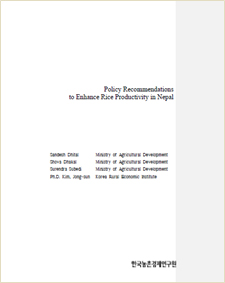
- Author: Sandesh Dhital (Ministry of Agricultural Development in Nepal)
Shova Dhakal (Ministry of Agricultural Development in Nepal)
Surendra Subedi (Ministry of Agricultural Development in Nepal)
Kim, Jong-sun (Korea Rural Economic Institute) - Publisher: Korea Rural Economic Institute(KREI)
- Publication Date: December, 2017
Full text will be updated in the KREI Website(www.krei.re.kr) soon.
Cherry Export Market in Korea

- Author: Ilkhom Ibragimov(International Finance Corporation)
Ph.D. Lee, Dae-sub (Korea Rural Economic Institute)
Salomat Abduramanova (Scientific Research Institute of Horticulture, Viticulture and Wine-making)
Chulpanoy (Kashkabaeva Scientific Research Institute of Horticulture, Viticulture and Wine-making) - Publisher: Korea Rural Economic Institute(KREI)
- Publication Date: December, 2017
The structure was studied for each producer country, in kind and in value terms. When analyzing the data, the main recipient companies of imported sweet cherries in Korea were identified. The price analysis was carried out, presenting data on average wholesale, retail and general market prices. The volumes of actual and potential market capacity were also determined. The main criterion for calculating the potential market volume is the possible level of consumption. Based on the available data and the statistical information received, the export potential of the Uzbek sweet cherry and the forecast export volumes of cherries by producer countries were determined. The basic quarantine requirements for Uzbek sweet cherries were also studied and presented.
Full text will be updated in the KREI Website(www.krei.re.kr) soon.
Lessons from Korean Cooperatives in Strengthening Food and Nutrition Security (FNS) for Small Dairy Farmers in Ubaté, Colombia
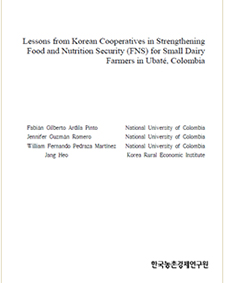
- Author: Fabián Gilberto Ardila Pinto (National University of Colombia)
Jennifer Guzmán Romero (National University of Colombia)
William Fernando Pedraza Martínez (National University of Colombia)
Jang Heo (Korea Rural Economic Institute) - Publisher: Korea Rural Economic Institute(KREI)
- Publication Date: December, 2017
To identify the elements that have contributed to the success of Korean agricultural cooperatives, and to utilize such elements to provide recommendations for small producers and decision-making processes, in order to improve the food and nutritional security of these actors and their families. Small producers need to diversify their production through multiple activities in order to link their products to value chains and marketing circuits, which reduce intermediation. It is necessary to make progress in the implementation of public policies that improve local infrastructure, roads and basic services, and strengthen inter-sectoral committees to form agreements with private companies on prices and product quality. Small producers can be organized non-hierarchically to support each other and manage cultural activities, housing improvement, rural extension, tourism services and climate change mitigation.
Full text will be updated in the KREI Website(www.krei.re.kr) soon.
Farmer`s Perception on Farm mechanization and Land reformation in the Philippines
Improving Aid Effectiveness in International Development Cooperation Efforts
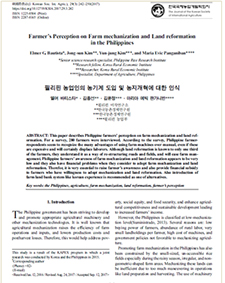
- Author: Elmer G. Bautista, Jong-sun Kim(KREI), Yun-jung Kim(KREI), Maria Evic Panganiban
- Publisher: The journal of the Korean Society of International Agriculture
- Publication Date: Sep. 2017
Full Text of the Report
Enhancing district delivery and management of agriculture extension in Lao PDR
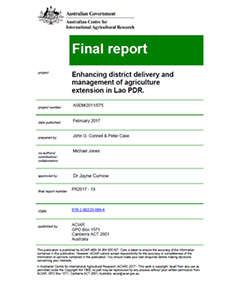
- Author: John G. Connell & Peter Case
- Publisher: Austrian Centre for International Agricultural Research
- Publication Date: Sep. 2017
This project aimed to address this problem by developing an Extension Management System (EMS) and guidelines for implementing a newly mandated set of comprehensive extension interventions, referred to in shorthand as farmer learning (FL), farmer organization (FO) and market engagement (ME). The project strategy was to enable selected DAFO in pilot study districts to operate with relative autonomy in the co-design, implementation and refinement of a set of EMS tools. Achieving demonstrable outcomes and impacts from such independent action would thus demonstrate DAFO’s capacity to perform well and also carry the prospect of persuading GoL authorities to invest in extension services. This strategy informed the three project objectives.
Full Text of the Report
Is Aid for Agriculture Effective in Sub-saharan Africa?
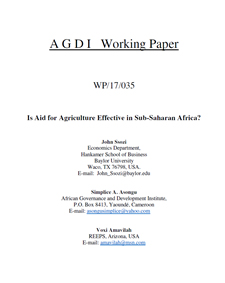
- Author: John Ssozi, Simplice A. Asongu, Voxi Heinrich S. Amavilah
- Publisher: Austrian Centre for International Agricultural Research
- Publication Date: Sep. 2017
Full Text of the Report

